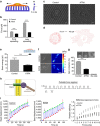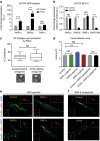ATRA mechanically reprograms pancreatic stellate cells to suppress matrix remodelling and inhibit cancer cell invasion
- PMID: 27600527
- PMCID: PMC5023948
- DOI: 10.1038/ncomms12630
ATRA mechanically reprograms pancreatic stellate cells to suppress matrix remodelling and inhibit cancer cell invasion
Abstract
Pancreatic ductal adenocarcinoma (PDAC) is a highly aggressive malignancy with a dismal survival rate. Persistent activation of pancreatic stellate cells (PSCs) can perturb the biomechanical homoeostasis of the tumour microenvironment to favour cancer cell invasion. Here we report that ATRA, an active metabolite of vitamin A, restores mechanical quiescence in PSCs via a mechanism involving a retinoic acid receptor beta (RAR-β)-dependent downregulation of actomyosin (MLC-2) contractility. We show that ATRA reduces the ability of PSCs to generate high traction forces and adapt to extracellular mechanical cues (mechanosensing), as well as suppresses force-mediated extracellular matrix remodelling to inhibit local cancer cell invasion in 3D organotypic models. Our findings implicate a RAR-β/MLC-2 pathway in peritumoural stromal remodelling and mechanosensory-driven activation of PSCs, and further suggest that mechanical reprogramming of PSCs with retinoic acid derivatives might be a viable alternative to stromal ablation strategies for the treatment of PDAC.
Figures






References
-
- Winter J. M. et al. Survival after resection of pancreatic adenocarcinoma: results from a single institution over three decades. Ann. Surg. Oncol. 19, 169–175 (2012). - PubMed
-
- Apte M. V. et al. Desmoplastic reaction in pancreatic cancer: role of pancreatic stellate cells. Pancreas 29, 179–187 (2004). - PubMed
-
- Vonlaufen A. et al. Pancreatic stellate cells: partners in crime with pancreatic cancer cells. Cancer Res. 68, 2085–2093 (2008). - PubMed
-
- Erkan M. et al. The role of stroma in pancreatic cancer: diagnostic and therapeutic implications. Nat. Rev. Gastroenterol. Hepatol. 9, 454–467 (2012). - PubMed
Publication types
MeSH terms
Substances
Grants and funding
LinkOut - more resources
Full Text Sources
Other Literature Sources
Research Materials

